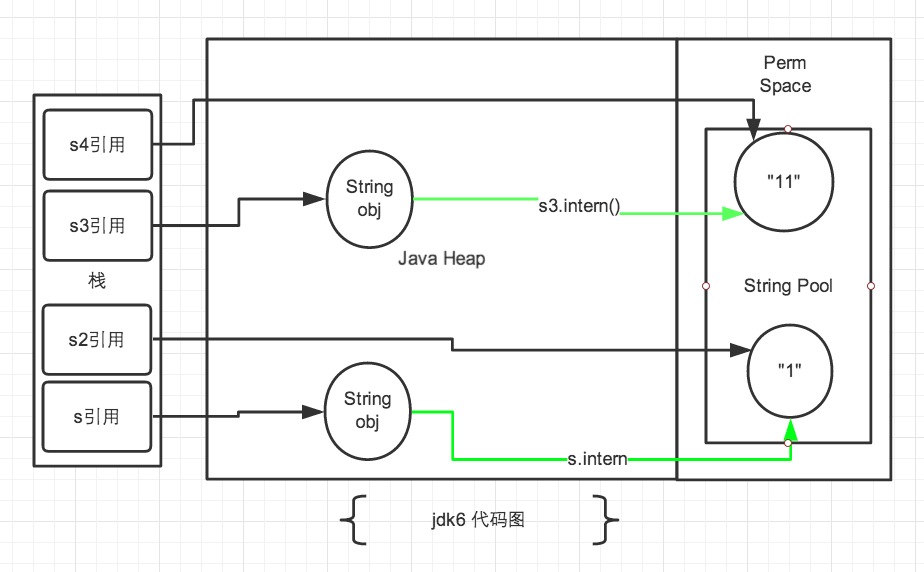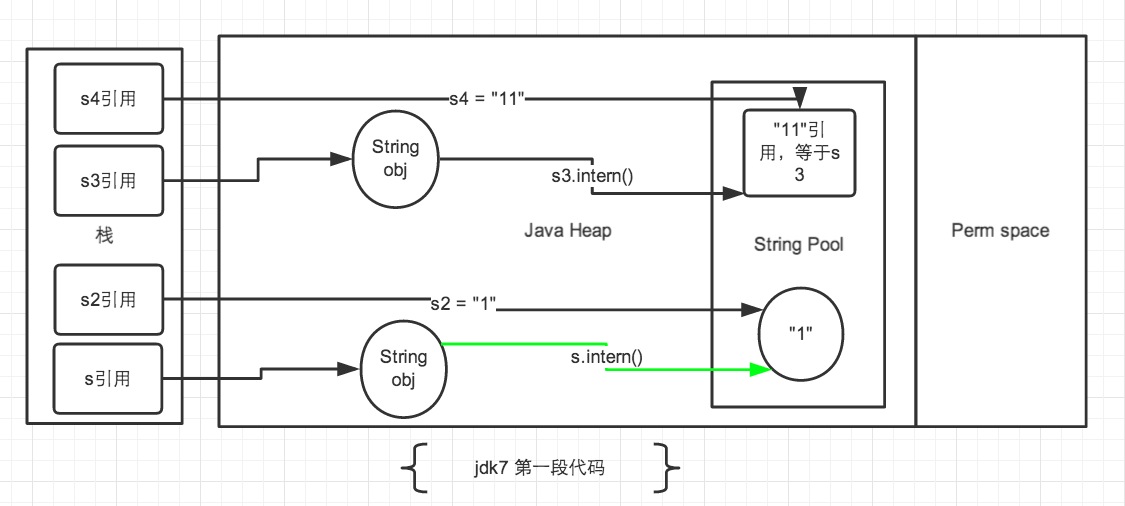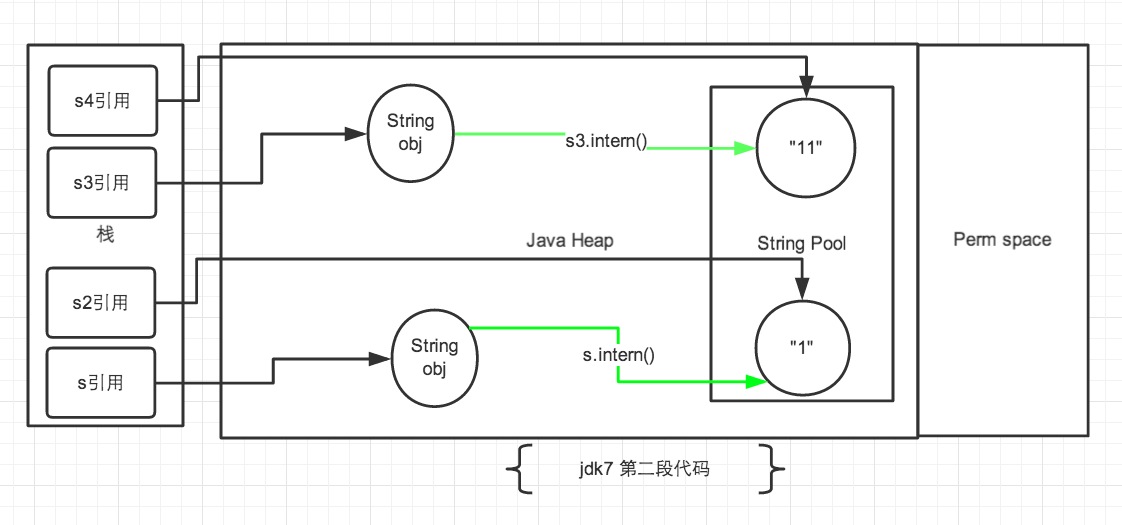

String常量池和String#intern()
source link: https://monkeysayhi.github.io/2017/12/15/String常量池和String-intern/?amp%3Butm_medium=referral
Go to the source link to view the article. You can view the picture content, updated content and better typesetting reading experience. If the link is broken, please click the button below to view the snapshot at that time.

String是Java基础的重要考点。可问的点多,而且很多点可以横向切到其他考点,或纵向深入JVM。
本文略过了String的基本内容,重点在于String#intern()。
String常量池
String常量可能会在两种时机进入常量池:
- 编译期:通过双引号声明的常量(包括显示声明、静态编译优化后的常量,如”1”+”2”优化为常量”12”),在前端编译期将被静态的写入class文件中的“常量池”。该“常量池”会在类加载后被载入“内存中的常量池”,也就是我们平时所说的常量池。同时,JIT优化也可能产生类似的常量。
- 运行期:调用String#intern()方法,可能将该String对象动态的写入上述“内存中常量池”。
时机1的行为是明确的。原理可阅读class文件结构、类加载、编译期即运行期优化等内容。
时机2在jdk6和jdk7中的行为不同,下面讨论。
String#intern()
读者可直接阅读参考资料。下述总结仅为了猴子自己复习方便。
* Returns a canonical representation for the string object. * <p> * A pool of strings, initially empty, is maintained privately by the * class <code>String</code>. * <p> * When the intern method is invoked, if the pool already contains a * string equal to this <code>String</code> object as determined by * the {@link #equals(Object)} method, then the string from the pool is * returned. Otherwise, this <code>String</code> object is added to the * pool and a reference to this <code>String</code> object is returned. * <p> * It follows that for any two strings <code>s</code> and <code>t</code>, * <code>s.intern() == t.intern()</code> is <code>true</code> * if and only if <code>s.equals(t)</code> is <code>true</code>. * <p> * All literal strings and string-valued constant expressions are * interned. String literals are defined in section 3.10.5 of the * <cite>The Java™ Language Specification</cite>. * @return a string that has the same contents as this string, but is * guaranteed to be from a pool of unique strings. public native String intern();String#intern()是一个native方法。根据Javadoc,如果常量池中存在当前字符串, 就会直接返回当前字符串. 如果常量池中没有此字符串, 会将此字符串放入常量池中后, 再返回。
JNI最后调用了c++实现的StringTable::intern()方法:
oop StringTable::intern(Handle string_or_null, jchar* name, int len, TRAPS) { unsigned int hashValue = java_lang_String::hash_string(name, len); int index = the_table()->hash_to_index(hashValue); oop string = the_table()->lookup(index, name, len, hashValue); // Found if (string != NULL) return string; // Otherwise, add to symbol to table return the_table()->basic_add(index, string_or_null, name, len, hashValue, CHECK_NULL); oop StringTable::lookup(int index, jchar* name, int len, unsigned int hash) { for (HashtableEntry<oop>* l = bucket(index); l != NULL; l = l->next()) { if (l->hash() == hash) { if (java_lang_String::equals(l->literal(), name, len)) { return l->literal(); return NULL; 在the_table()返回的hash表中查找字符串,如果存在就返回,否则加入表。
StringTable是一个固定大小的Hashtable,默认大小是1009。基本逻辑与Java中HashMap相同,也使用拉链法解决碰撞问题。
既然是拉链法,那么如果放进的String非常多,就会加剧碰撞,导致链表非常长。最坏情况下,String#intern()的性能由O(1)退化到O(n)。
- jdk6中StringTable的长度固定为1009。
- jdk7中,StringTable的长度可以通过一个参数
-XX:StringTableSize指定,默认1009。
jdk6和jdk7下String#intern()的区别
相信很多Java程序员都做类似String s = new String("abc");这个语句创建了几个对象的题目。这种题目主要是为了考察程序员对字符串对象常量池的掌握。上述的语句中创建了2个对象:
- 第一个对象,内容”abc”,存储在常量池中。
- 第二个对象,内容”abc”,存储在堆中。
来看一段代码:
public static void main(String[] args) { String s = new String("1"); s.intern(); String s2 = "1"; System.out.println(s == s2); String s3 = new String("1") + new String("1"); s3.intern(); String s4 = "11"; System.out.println(s3 == s4);打印结果:
# jdk6下false false# jdk7下false true具体为什么稍后再解释,然后将s3.intern();语句下调一行,放到String s4 = "11";后面。将s.intern();放到String s2 = "1";后面:
public static void main(String[] args) { String s = new String("1"); String s2 = "1"; s.intern(); System.out.println(s == s2); String s3 = new String("1") + new String("1"); String s4 = "11"; s3.intern(); System.out.println(s3 == s4);打印结果:
# jdk6下false false# jdk7下false falsejdk6的解释

注:图中绿色线条代表String对象的内容指向;黑色线条代表地址指向。
jdk6中,上述的所有打印都是false。
因为jdk6的常量池放在Perm区中,和正常的Heap(指Eden、Surviver、Old区)完全分开。具体来说:使用引号声明的字符串都是通过编译和类加载直接载入常量池,位于Perm区;new出来的String对象位于Heap(E、S、O)中。拿一个Perm区的对象地址和Heap中的对象地址进行比较,肯定是不相同的。
Perm区主要存储一些加载类的信息、静态变量、方法片段、常量池等。
jdk7的解释
在jdk6及之前的版本中,字符串常量池都是放在Perm区的。Perm区的默认大小只有4M,如果多放一些大字符串,很容易抛出OutOfMemoryError: PermGen space。
因此,jdk7已经将字符串常量池从Perm区移到正常的Heap(E、S、O)中了。
Perm区即永久代。本身用永久代实现方法区就容易遇到内存溢出;而且方法区存放的内容也很难估计大小,没必要放在堆中管理。jdk8已经取消了永久代,在堆外新建了一个Metaspace实现方法区。
正是因为字符串常量池移到了Heap中,才产生了上述变化。
第一段代码

先看s3和s4:
- 首先,
String s3 = new String("1") + new String("1");,生成了多个对象,s3最终指向堆中的”11”。注意,此时常量池中是没有字符串”11”的。 - 然后,
s3.intern();,将s3中的字符串”11”放入了常量池中,因为此时常量池中不存在字符串”11”,因此常规做法与跟jdk6相同,在常量池中生成一个String对象”11”——然而,jdk7中常量池不在Perm区中了,相应做了调整:常量池中不需要再存储一份对象了,而是直接存储堆中的引用,也就是s3的引用地址。 - 接下来,
String s4 = "11";,”11”通过双引号显示声明,因此会直接去常量池中查找,如果没有再创建。发现已经有这个字符串了,也就是刚才通过s3.intern();存储在常量池中的s3的引用地址。于是,直接返回s3的引用地址,s4赋值为s3的引用,s4指向堆中的”11”。 - 最后,s3、s4指向的堆中的”11”,常量池中存储s3的引用,满足
s3 == s4。
再看s和s2:
- 首先,
String s = new String("1");,生成了2个对象,常量池中的”1”和堆中的”1”,s指向堆中的”1”。 - 然后,
s.intern();,上一句已经在常量池中创建了”1”,所以此处什么都不做。 - 接下来,,
String s2 = "1";,常量池中有”1”,因此,s2直接指向常量池中的”1”。 - 最后,s指向的堆中的”1”,s2指向常量池中的”1”,常量池中存储字符串”1”,不满足
s == s2。
第二段代码

先看s3和s4,将s3.intern();放在了String s4 = "11";后:
- 先执行
String s4 = "11";,此时,常量池中不存在”11”,因此,将”11”放入常量池,然后s4指向常量池中的”11”。 - 再执行
s3.intern();,上一句已经在常量池中创建了”11”,所以此处什么都不做。 - 最后,s3仍指向的堆中的”11”,s4指向常量池中的”11”,常量池中存储字符串”11”,不再满足
s3 == s4。
再看s和s2,将s.intern();放到String s2 = "1";后:
- 先执行
String s2 = "1";,之前已通过String s = new String("1");在常量池中创建了”1”,因此,s2直接指向常量池中的”1”。 - 再执行
s.intern();,常量池中有”1”,所以此处什么都不做。 - 最后,s指向的堆中的”1”,s2指向常量池中的”1”,常量池中存储字符串”1”,仍不满足
s == s2。
jdk7与jdk6相比,对String常量池的位置、String#intern()的语义都做了修改:
- 将String常量池从Perm区移到了Heap区。
- 调用String#intern()方法时,堆中有该字符串而常量池中没有,则直接在常量池中保存堆中对象的引用,而不会在常量池中重新创建对象。
建议直接阅读参考资料。
额外的问题
String#intern()的基本用法如下:
String s1 = xxx1.toString().intern();String s2 = xxx2.toString().intern();assert s1 == s2;然而,xxx1.toString()、xxx2.toString()已经创建了两个匿名String对象,这之后再调用String#intern()。那么,这两个匿名对象去哪了?
估计猴子对创建对象的过程理解有问题,或许
xxx1.toString()返回时还没有将对象保存到堆上?或许String#intern()上做了什么语法糖?后面有时间再解决吧。。。
Recommend
About Joyk
Aggregate valuable and interesting links.
Joyk means Joy of geeK